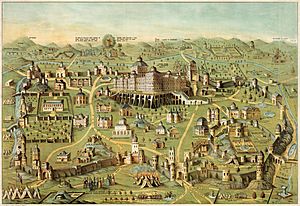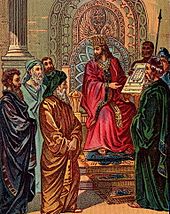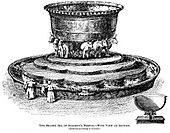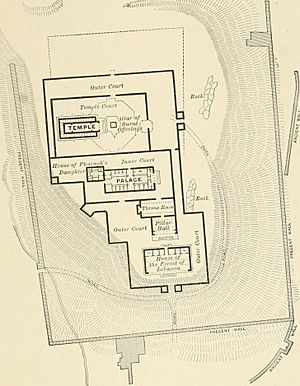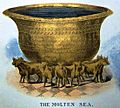Solomon's Temple facts for kids
Quick facts for kids Solomon's Temple |
|
|---|---|
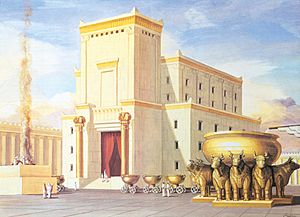
Artistic depiction of the First Temple
|
|
| Religion | |
| Deity | Yahweh |
| Location | |
| Location | Ancient Jerusalem |
| Architecture | |
| Creator | Solomon |
| Destroyed | 587 BC |
According to the Hebrew Bible, Solomon’s Temple was the first special building the Israelites built for God. It was also called the First Temple. King Solomon built it. It stood next to the king’s palace. It was seen as God’s royal home and the main place for Israel to worship. The Bible says that the Lord told Solomon, “I have made this temple special by putting my Name there forever. My eyes and my heart will always be there” (1 Kings 9:3).
This temple was a sign of holiness and royalty. It reminded the Israelites that God was their special leader. Its design was like the tabernacle and other temples of that time. It had three important areas: the Most Holy Place, the Holy Place, and the outer courtyard. It was built in Jerusalem, on a piece of land King David, Solomon's father, had bought.
Contents
History of Solomon's Temple
Historians believe the Temple was finished around 960 BCE. The Babylonians destroyed it in 587 or 586 BCE. Some ancient Jewish writings say the temple stood for 410 years. These writings suggest it was built in 832 BCE and destroyed in 433 BCE. This is about 165 years later than what other historians believe.
So far, no clear archaeological proof of Solomon's Temple has been found. All we know about the First Temple in Jerusalem comes from the Bible. You can read about it in the books of Joshua, Judges, 1-2 Samuel, and 1-2 Kings.
Building the Temple: A Bible Story
King David's Dream
At first, King David wanted to build a temple for God. But the Bible says God told him through the prophet Nathan: "You are not to build a house for my Name. This is because you are a warrior and have shed blood." Instead, God chose David's son, Solomon, to build the temple.
Before David died, he gave Solomon the plans for the temple. He also gave instructions for the priests and Levites. David even gave his own money to help build it. He asked the people to give gifts of money too.
Getting Materials for the Temple
King Solomon sent a message to Hiram, the king of Tyre. Hiram had been friends with David and had sent him lots of wood for his palace. Solomon told Hiram he wanted to build a temple for the Lord. He asked Hiram to send him wood.
Hiram agreed, if Solomon would provide food for the wood and the workers. So, Hiram gave Solomon all the cedar and pine logs he wanted. Solomon gave Hiram wheat for his family. He also gave him about 115,000 gallons (434,000 liters) of olive oil. King Hiram cut down the wood and sent it on rafts to Joppa. From there, the wood could be taken up to Jerusalem.
The Temple is Built
The Bible says, “In the 480th year after the Israelites left Egypt, in the fourth year Solomon ruled over Israel, he began to build the temple of the LORD.” (1 Kings 6:1)
King Solomon brought in a skilled craftsman named Huram-Abi. His mother was from the tribe of Naphtali, and his father was from Tyre. Huram was very good at all kinds of work. The Bible says he was skilled in working with gold, silver, bronze, iron, and different colored yarn. He was especially good with bronze.
When all the work for the temple was finished, King Solomon brought in the special items his father David had given to God. He put them in the temple's treasuries. The Bible says, "In the eleventh year, in the month of Bul, the eighth month, the temple was finished in all its details according to its specifications." (1 Kings 6:38 NIV)
Giving the Temple to God
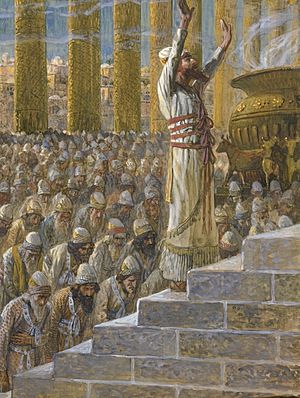
When the temple was ready, King Solomon brought the Ark of the Covenant to it. He gathered all the people of Israel. They sacrificed so many sheep and cattle that they could not be counted.
Then, a cloud filled the temple. This showed that God was present, just as He had shown Himself on the tabernacle at Mt. Sinai. King Solomon praised God. He said a special prayer of dedication, giving the temple to God. He asked God to keep His promise to King David, that David's sons would rule forever.
Solomon also said, "But will God really live on earth? The heavens, even the highest heaven, cannot hold you. How much less this temple I have built!" This reminded everyone that God is too big to be contained in any building. Even so, He chose to be with the people of Israel in a special way.
Solomon asked God to answer the people of Israel when they prayed towards the temple. He asked God to hear from heaven when someone sinned, or when enemies came, or when there was drought or famine. He prayed, "...whatever disaster or disease may come, and when a prayer or plea (request) is made by any of your people Israel...then hear from heaven, your dwelling place. Forgive and act; deal with each man according to all he does, since you know his heart (for you alone know the hearts of all men), so that they will fear you all the time they live in the land you gave our fathers" (1 Kings 8:38-40).
Then Solomon stood up and blessed the people of Israel. He gave many sacrifices to God: "twenty thousand cattle and a hundred and twenty thousand sheep and goats. So the king and all the Israelites dedicated the temple of the LORD" (1 Kings 8:63, NIV).
God Speaks to Solomon
The Bible says that after Solomon finished the temple, God appeared to him. God said, "I have heard the prayer and plea you have made before me...My eyes and my heart will always be there [at the temple you have made]."
However, God also warned Solomon. He said it was important to obey God's promise (covenant) to receive its blessings, not its curses. This warning was important because God had given Solomon great power and wealth. Sometimes, people with much wealth forget God's promises.
Solomon also gave King Hiram of Tyre 20 towns in Galilee. This was because Hiram had given him all the cedar, pine, and gold he needed. But Hiram did not like the towns. He said, "What kind of towns are these you have given me, my brother?" (1 Kings 9:13, NIV). He called them the Land of Cabul, which means "good-for-nothing" in Hebrew. Solomon might have owed Hiram more than he first thought. He probably gave the towns as a promise to pay him later. The Bible says that later, Solomon became richer. This might have been from a trip to Ophir or a visit from the queen of Sheba.
Temple Design and Features
Solomon's Temple was built next to the king's palace. Its floor plan was similar to other temples in the West Semite region. It had three main parts:
- A front porch or entrance area.
- A main hall.
- An inner, most holy room.
Similar designs have been found in ancient places like Syrian Ebla (around 2300 B.C.) and Tell Tainat (around 900 B.C.). Like Solomon's Temple, the Tell Tainat temple also had two columns at its entrance. In Solomon's temple, these columns were named Jakin and Boaz.
The Ark of the Covenant was placed inside the Most Holy Place. This room was about 30 feet (9 meters) long, wide, and high. It was covered with pure gold. Solomon used a lot of gold in the temple. This bright gold likely symbolized God's glory and His heavenly temple. Inside the temple, there were carvings of cherubim (angel-like figures), palm trees, and flowers. These carvings reminded people of the Garden of Eden. Humans could not live in Eden anymore because of their sin. The temple was a symbol that the Israelites could come back to paradise through the temple.
Items Inside the Temple
Some discoveries today match the descriptions in 1 Kings 6-7 of items found in the temple.
Movable Bronze Basins
Archaeologists have found something very similar to the wheeled movable basins used in the temple courtyard. These were found during archaeological digs on Cyprus.
Table for the Bread of the Presence
A stone altar with four horns on its corners was found at Megiddo. It gives us a good idea of what the gold altar in the temple looked like. The table for the Bread of the Presence was also made of gold. The Bread of the Presence (twelve pieces of bread, one for each tribe of Israel) was a continuous offering to God. It showed that Israel gave God what they earned and that everything they had was a blessing from God.
Lamp Stands
There were ten lamp stands in the temple. Five were on each side of the sanctuary (1 Kings 7:49). Lamps like these have been found in many places in Palestine, including Hazor and Dothan.
Other pages
Images for kids
See also
 In Spanish: Templo de Salomón para niños
In Spanish: Templo de Salomón para niños


